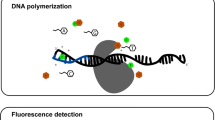Abstract
Achondroplasia is the most common form of dwarfism and has an incidence of approximately 1/7500. In more than 97% of cases, it is caused by a recurrent point mutation, a G to A substitution at nucleotide position 1138 (G1138A) of the fibroblast growth factor receptor 3 gene. Although this is an autosomal dominant condition, more than 90% of all mutations occur sporadically making this one of the most mutagenic sites in the human genome. The reasons for the high spontaneous G1138A mutation rate are not known. This investigation was performed by developing a simple and rapid semi-quantitative allele specific PCR based assay capable of reliably detecting more than 25 mutant G1138A copies in a pool of 300 000 wild type molecules. Using this assay, the G1138A mutation frequency was measured in cell lines deficient in mismatch repair (LoVo, SW48) and comparing it with controls. No differences were found in the frequency of this point mutation between the mismatch repair deficient and wild type cell lines.
Similar content being viewed by others
REFERENCES
Shiang, R., Thompson, L.M., Zhu, Y., et al., Mutations in the Transmembrane Domain of FGFR3 Cause the Most Common Genetic Form of Dwarfism, Achondroplasia, Cell (Cambridge, Mass.), 1994, vol. 78, pp. 335–342.
Muenke, M. and Schell, U., Fibroblast-Growth-Factor Receptor Mutations in Human Skeletal Disorders, Trends Genet., 1995, vol. 11, pp. 308–313.
Bellus, G.A., Hefferon, T.W., de Luna, O., et al., Achondroplasia is Defined by Recurrent G380R Mutations of FGFR3, Am. J. Hum. Genet., 1995, vol. 56, pp. 368–373.
Driscoll, D.J. and Migeon, B.R., Sex Difference in Methylation of Single-Copy Genes in Human Meiotic Germ Cells: Implications for X Chromosome Inactivation, Parental Imprinting and Origin of CpG Mutations, Somatic Cell Mol. Genet., 1990, vol. 16, pp. 267–282.
Wolfe, K.H., Sharp, P.M., and Li, W.H., Mutation Rates Differ among Regions of the Mammalian Genome, Nature, 1989, vol. 337, pp. 283–285.
Cooper, D.N. and Krawczak, M., The Mutational Spectrum of Single Base-Pair Substitutions Causing Human Genetic Disease: Patterns and Predictions, Hum. Genet., 1990, vol. 85, p. 85.
Lichtenauer-Kaligis, E.G., van der Velde-va Dijke, I., Dulk, H., et al., Genomic Position Influences Spontaneous Mutagenesis of an Integrated Retroviral Vector Containing the hprt cDNA As a Target for Mutagenesis, Hum. Mol. Genet., 1993, no. 2, pp. 173–182.
Arnheim, N. and Shibata, D., DNA Mismatch Repair in Mammals: Role in Disease and Meiosis, Curr. Opin. Genet. Dev., 1997, no. 7, pp. 364–370.
Bhattacharyya, N.P., Ganesh, A., and Phear, G., Molecular Analysis of Mutations in Mutator Colorectal Carcinoma Cell Lines, Hum. Mol. Genet., 1995, no. 4, pp. 2057–2064.
Phear, G., Bhattacharyya, N.P., and Meuth, M., Loss of Heterozygosity and Base Substitution at the APRT Locus in Mismatch-Repair-Proficient and-Deficient Cell Lines, Mol. Cell. Biol., 1996, no. 16, pp. 6516–6523.
Bhattacharyya, N.P., Skandilis, A., Ganesh, A., et al., Mutator Phenotypes in Human Colorectal Carcinoma Cell Lines, Proc. Natl. Acad. Sci. USA, 1994, vol. 91, pp. 6319–6323.
Ugozzoli, L. and Wallace, R.B., Allele-Specific Polymerase Chain Reaction, Methods: A Comparison to Methods in Enzymology, 1991, vol. 2, pp. 1–7.
Newton, C.R., Graham, A., and Heptinstall, L.E., Analysis of Any Point Mutation in DNA: The Amplification Refractory Mutation System (ARMS), Nucleic Acids Res., 1989, vol. 17, pp. 2503–2516.
Huang, M., Arnheim, N., and Goodman, M.F., Extension of Base Mispairs by Taq DNA Polymerase: Implications for Single Nucleotide Discrimination in PCR, Nucleic Acids Res., 1992, vol. 20, pp. 4567–4573.
Soong, N.W. and Arnheim, N., Detection and Quantification of Mitochondrial DNA Deletions, Methods Enzymol., 1996, vol. 264, pp. 421–431.
Tiemann-Boege, I., Navidi, W., Grewal, R., et al., The Observed Human Sperm Mutation Frequency Cannot Explain the Achondroplasia Paternal Age Effect, Proc. Natl. Acad. Sci. USA, 2002, vol. 99, pp. 14 952–14 957.
Wood, R.D., Mitchell, M., Sgouros, J., and Lindahl, T., Human DNA Repair Genes, Science, 2001, vol. 291, pp. 1284–1289.
Cooper, D.N. and Krawczak, M., Human Gene Mutation, Oxford: BIOS Sci., 1993.
Author information
Authors and Affiliations
Additional information
__________
From Genetika, Vol. 41, No. 8, 2005, pp. 1137–1141.
Original English Text Copyright © 2005 by Grewal.
This article was submitted by the author in English.
Rights and permissions
About this article
Cite this article
Grewal, R.P. A Simple and Rapid Quantitative Method of Detection of the Common Achondroplasia Mutation: Analysis in Mismatch Repair Deficient Cells. Russ J Genet 41, 932–935 (2005). https://doi.org/10.1007/s11177-005-0183-9
Received:
Issue Date:
DOI: https://doi.org/10.1007/s11177-005-0183-9




